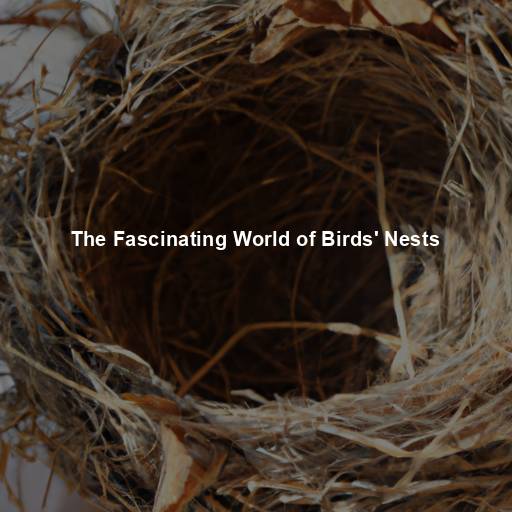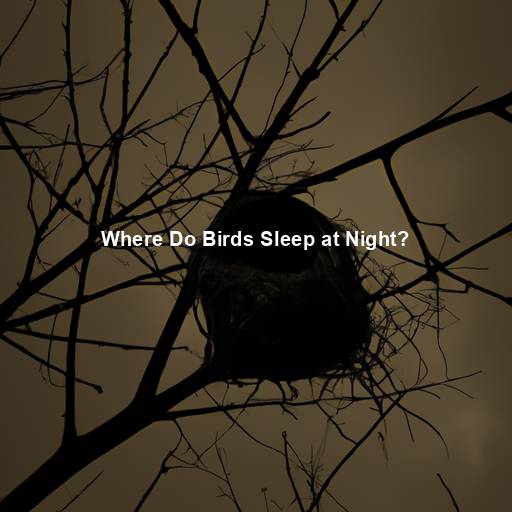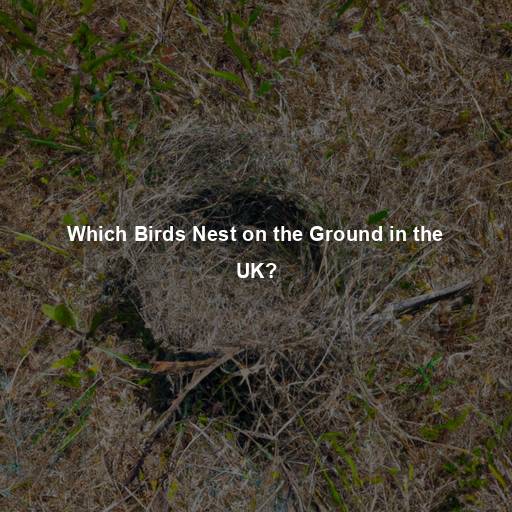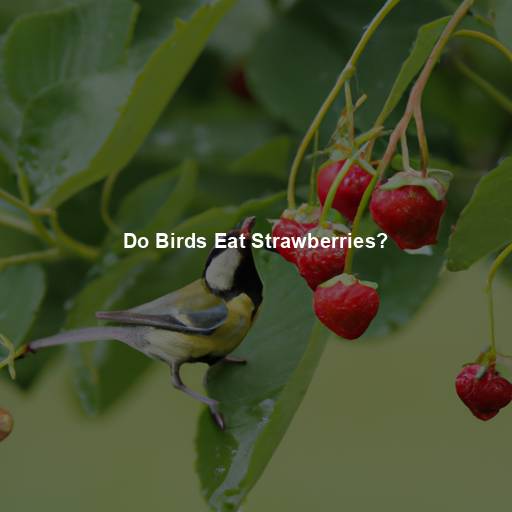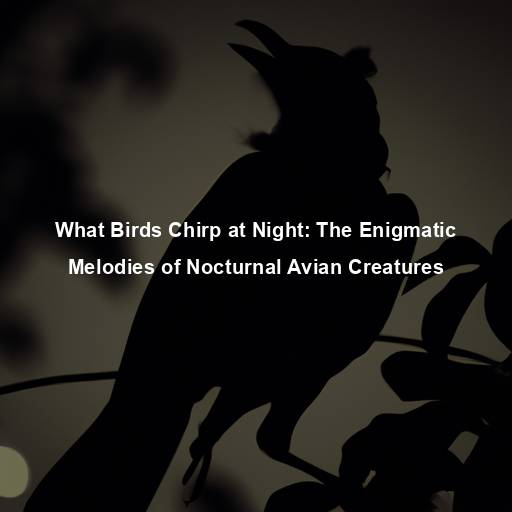The Fascinating World of Birds’ Nests
Last Updated on July 16, 2023 by Evan
Contents [hide]
- 1 The Diversity of Birds’ Nests
- 2 Exploring Birds’ Nests: A Window into Avian Lives
- 3 Nest Building: An Ingenious Avian Endeavor
- 4 Birds’ Nests and Conservation
- 5 Unveiling the Secrets of Birds’ Nests: A Never-Ending Exploration
- 6 The Evolutionary Significance of Birds’ Nests
- 7 The Cultural Significance of Birds’ Nests
- 8 The Wonders of Birds’ Nests: A Never-Ending Journey of Discovery
- 9 FAQs
The Diversity of Birds’ Nests
The sheer diversity and complexity of birds’ nests never fail to astound. These miniature works of art are testaments to nature’s boundless creativity, leaving us in awe of the ingenuity displayed by our avian companions. From meticulously woven nests that could rival the expertise of expert basket weavers to humble ground depressions cleverly hidden amidst foliage, each design bears the unmistakable signature of its architect. Join us as we embark on a journey into the extraordinary world of birds’ nests, where every discovery promises to unravel the enigmatic allure of these remarkable creations.
The Purpose of Birds’ Nests
Birds’ nests serve as safe havens for breeding, incubating eggs, and raising offspring. These nests provide protection from predators, adverse weather conditions, and other potential threats, ensuring the survival of the next generation. The construction and maintenance of nests are essential aspects of avian behavior and are often influenced by factors such as habitat, diet, and mating rituals.
Nest Construction Techniques
The artistry and resourcefulness of our feathered friends in their nest-building endeavors never ceases to amaze. Take the baya weaver bird, for instance, a maestro of complexity and precision. With a deft touch, it weaves nature’s humble offerings into breathtaking structures, suspended delicately from branches. These architectural marvels, offering security from predators and the capricious whims of weather, stand as testaments to the ingenuity of the avian kingdom.
Nesting Materials
In the eclectic world of avian abodes, the medley of materials that birds utilize for their nests is as intriguing as the birds themselves. From twigs to leaves, grasses to moss, and even the gossamer threads of spider silk, these feathered architects know no bounds in their quest for the perfect dwelling. The diversity expands further as each species develops a distinct penchant for specific building blocks, adapting to their surroundings and the unique demands of their offspring. Take, for instance, the American goldfinch, with its exquisite nest woven intricately with plant fibers and delicate grasses, fashioning an oasis of comfort and solace for its precious eggs and tender hatchlings.
Nests as Architectural Marvels
Birds’ nests are not only functional but also showcase impressive architectural skills. The complexity and intricacy of some nest structures are truly awe-inspiring. Take, for instance, the hanging nests of the Montezuma oropendola, which are woven with long fibers and suspended from tree branches. These pendulous nests can reach up to 3 meters in length and are a testament to the bird’s engineering prowess.
Nests as Works of Art
In addition to their utilitarian purpose, some birds’ nests can be considered works of art. The male bowerbird, renowned for its elaborate courtship rituals, builds intricate bowers adorned with colorful objects like flowers, berries, and feathers. These intricate displays are designed to attract potential mates and demonstrate the male’s creativity and resourcefulness.
Nesting Strategies
Birds employ various strategies to ensure the survival of their offspring. Some species, like the albatross, construct nests in isolated locations to avoid disturbance and predation. Others, such as the African fish eagle, build their nests near bodies of water to facilitate easy access to food for both themselves and their young. These strategies highlight the adaptability and resourcefulness of birds in different environments.
Nest Parasitism
While most birds diligently build their own nests, some species take a different approach. These birds, known as brood parasites, lay their eggs in the nests of other bird species, leaving the responsibility of incubation and rearing to the unwitting hosts. The infamous cuckoo bird is a classic example of a brood parasite, often depositing its eggs in the nests of smaller birds. The unsuspecting host birds then raise the cuckoo chick as their own.
Nesting Challenges and Adaptations
The art of nesting, dear readers, is a perplexing endeavor for our winged friends. Imagine the upheavals they endure – stealthy predators lurking, tempestuous weather, and the relentless destruction of their homes. Yet, in the face of such adversity, birds display bursts of brilliance. Take, for instance, the marvelous African grey hornbill – it seals the entrance to its cozy nest with a shield of mud, slyly leaving a tiny slit for sustenance to pass through.
Exploring Birds’ Nests: A Window into Avian Lives
Delving into the mysterious world of avian abodes, one can’t help but marvel at the spellbinding array of nests that dot our landscape. A melange of designs, materials, and methodologies unfolds before our bewildered gaze, leaving us in a state of awe and wonder. These nests, a testament to the resourcefulness and adaptability of birds, offer a window into their captivating lives – a tapestry woven with the threads of instinct, survival, and artistry. As we behold these intricate and diverse structures, we unearth the secrets of avian behavior, habitat preferences, and the hidden chapters of their evolutionary journey.
Factors Influencing Nest Site Selection
Birds, the architects of nature, have been astoundingly meticulous in their quest for building the perfect abode. With uncanny deliberation, they weigh the prospects of every location, taking into account a myriad of intricate variables that spell the difference between survival and peril. From the availability of the finest nesting materials to the ever-present threat of lurking predators, their choices reflect a delicate dance between camouflage and accessibility to life-sustaining nourishment. These decisions, seemingly routine for the radiant avian creatures, hold the power to shape the destiny of not only their fragile eggs but also the vibrant future of their fledglings.
Camouflage and Concealment
Birds have their own little tricks up their feathers when it comes to keeping their nests safe. They’ve mastered the art of blending in with their surroundings, like avian ninjas. Take the killdeer for example, these ground-nesting champs lay their eggs in cleverly disguised shallow depressions, perfectly mirroring the gravel or dirt nearby. It’s no wonder predators are left scratching their heads, completely fooled by nature’s camouflage masterpiece.
Nesting in Unusual Places
Amidst the vast avian world, where nest-building takes on varying forms, certain species stand out with their peculiar choices. Take, for instance, the peregrine falcon, which defies convention by constructing its nest precariously on sheer cliff faces or rocky ledges, creating a spectacle that perplexes onlookers and keeps ground-dwelling predators at bay. Equally fascinating are the cavity-nesting birds, such as woodpeckers and bluebirds, who possess the remarkable ability to excavate holes within tree trunks or cunningly repurpose existing cozy nooks as their safe havens. Nature’s tapestry of nest-building behaviors is as wondrous as it is diverse.
Nesting in Human Structures
As human civilization expands its reach, the animal kingdom is not left behind. Birds, in particular, have shown remarkable adaptability to urban settings, finding innovative ways to utilize the architecture we create. Take the chimney swifts, for example, cleverly crafting their nests within the confines of chimneys, or the barn swallows, skillfully fashioning cup-shaped homes in the hidden nooks of barns and other human-made structures. This incredible ability to coexist and thrive amidst our bustling urban landscapes is truly a testament to the resilience and resourcefulness of these avian creatures.
Nest Building: An Ingenious Avian Endeavor
The Architectural Process
Nest building is a remarkable process that showcases the resourcefulness and ingenuity of birds. It typically begins with the selection of a suitable site, followed by the collection of nesting materials. Birds meticulously shape and arrange these materials to create a sturdy and well-insulated structure.
Male Involvement in Nest Building
In some bird species, nest building is a collaborative effort between males and females. The male bird often takes the lead in constructing the nest, showcasing his skills and creativity to attract a potential mate. The female then inspects the nest and may make adjustments or additions before laying her eggs.
Nest Maintenance and Repair
Nests require regular maintenance to ensure their structural integrity and the well-being of the nesting birds. Birds may reinforce the nest with additional materials, repair any damage caused by weather or predators, or remove waste and debris. Some species, like the bald eagle, may even return to the same nest year after year, continually adding new materials to expand and reinforce it.
Birds’ Nests and Conservation
Nest Preservation
Preserving and protecting birds’ nests is crucial for the conservation of avian species. Destruction or disturbance of nests can have severe consequences, leading to the abandonment of eggs or the loss of young birds. It is essential to raise awareness about the importance of nest preservation and educate individuals about the potential impacts of their actions on bird populations.
Providing Nesting Opportunities
Creating suitable nesting opportunities can be beneficial for both birds and humans. Installing birdhouses, nesting platforms, or providing appropriate vegetation can attract nesting birds to urban and suburban areas. These artificial nesting sites can help mitigate the loss of natural nesting habitats and provide much-needed shelter for birds to raise their young.
Citizen Science and Nest Monitoring
Citizen science initiatives play a vital role in monitoring and studying bird populations and their nesting behaviors. By participating in programs such as nest monitoring projects, individuals can contribute valuable data that helps researchers understand nesting success rates, breeding patterns, and population trends. This knowledge is essential for developing effective conservation strategies.
Unveiling the Secrets of Birds’ Nests: A Never-Ending Exploration
Birds’ nests have long captured the imaginations of curious onlookers, intriguing us with their intricate designs and inspiring stories of resilience and nurturing. Each nest we encounter holds a tale of adaptation, an insight into the remarkable bond between parent and offspring. Delving into the study of these nests allows us to unravel the mysteries of avian behavior, to uncover the delicate dance of survival and sacrifice that takes place within their woven walls. As we venture into the realm of birds’ nests, we embark on an exhilarating journey of exploration, widening our knowledge and deepening our appreciation for the complexity and beauty that nature bestows upon us.
Nest Site Selection
Birds carefully choose the location of their nests, considering factors such as safety, accessibility to food sources, and protection from predators and adverse weather conditions. Some birds, like the osprey, select nest sites near bodies of water to ensure a steady supply of fish for their young. Others, such as the bald eagle, choose tall trees near open spaces to provide a vantage point for spotting potential threats.
Parental Care and Incubation
When it comes to the delicate art of parenting, birds truly spread their wings and fly high in the game. Their commitment to nurturing their young is nothing short of awe-inspiring, and one of the key chapters in this remarkable journey is incubation. It’s like a carefully choreographed dance, with both parents taking turns in fostering the eggs, ensuring a harmonious balance between warmth and survival. This beautiful partnership allows them to not only provide for their precious offspring but also take some well-deserved breaks to recharge their feathers and refuel their energy.
Nest Defense and Predator Deterrence
As parents, birds exhibit remarkable dedication in safeguarding their nests from lurking predators. With a repertoire of awe-inspiring tactics, these feathered guardians leave no stone unturned to ensure the safety of their offspring. Take the charismatic mockingbird, for instance, whose feisty nature compels it to dive-bomb intruders and unleash a cacophony of warning calls, leaving trespassers in a state of bewilderment. Meanwhile, the resourceful wood duck opts for strategic nesting spots nestled within tree cavities or hidden amidst dense foliage, creating a natural veil that confounds potential predators and minimizes the risk of predation.
Feeding and Fledgling
In the intricate world of avian parenthood, a mesmerizing display of dedication and resourcefulness unfolds. From the moment those delicate eggs crack open, parents are propelled into a whirlwind of nourishment for their ravenous chicks. With a tireless determination, they scour the surrounding landscape in search of unsuspecting insects, small creatures, or even the remnants of their own meals, generously shared through the act of regurgitation. The remarkable intricacies do not stop there, as the amount and frequency of these feeding rituals fluctuate, adapting to the needs of each species and the ever-evolving developmental stages of their growing offspring.
The Evolutionary Significance of Birds’ Nests
Nest Evolution and Avian Success
The sheer ingenuity displayed by birds when it comes to building their nests has undoubtedly played a pivotal role in their remarkable adaptation and proliferation. These remarkable structures serve as sanctuaries, shielding delicate eggs and vulnerable fledglings from the perils of the outside world. By possessing this remarkable skill, birds have been able to colonize even the harshest of landscapes, demonstrating their uncanny ability to thrive in a multitude of ecological niches.
Coevolution with Parasites and Predators
Throughout the ages, the art of nest-building among birds has not only influenced their homes but also their relationships with other species. Those birds that invest their time and energy in crafting intricate nests have unknowingly shielded themselves from the clutches of nest parasites. The elaborate and perplexing structures have become a formidable obstacle for these intruders, preventing them from getting to the precious eggs or vulnerable young. Moreover, an extraordinary example of cooperation in the avian world can be witnessed in the African honeyguide, as it has formed a curious partnership with other species.
Nest Architecture and Mate Choice
Discover the enigmatic world of avian romance, where feathered suitors use their nests as captivating works of art to win the hearts of potential mates. These feathered architects showcase not only their genetic prowess but also their potential as nurturing fathers, as the quality and location of their nests become a key criterion for discerning females. In this intricate dance of courtship, the selection of the ideal nest site and the meticulous construction process serve as alluring displays of affection and commitment.
The Cultural Significance of Birds’ Nests
Nests in Human Culture
Throughout recorded time, the enigmatic allure of birds’ nests has effortlessly bewitched mankind, igniting the flames of imagination and sparking a kaleidoscope of cultural interpretations. The ethereal weave of intricacy and fragility within these avian creations has forged an unbreakable link to notions of sanctuary, guardianship, and tender care. Symbolically interwoven within the fabric of literature, art, and folklore, nests stand as profound beacons, an embodiment of family, refuge, and the eternal rhythm of existence.
Harvesting and Trade of Bird Nests
In some cultures, bird nests have culinary and medicinal value. Edible bird nests, such as those made by swiftlets, are highly prized for their gelatinous texture and are considered a delicacy in certain Asian cuisines. Unfortunately, the demand for bird nests has led to illegal harvesting and trade, threatening the populations of some bird species. Conservation efforts are crucial to protect these birds and their habitats.
Birdwatching and Nest Observation
For bird enthusiasts and researchers, observing birds’ nests provides valuable insights into avian behavior and ecology. Birdwatchers often seek out nesting sites to observe breeding behaviors, monitor nesting success, and contribute to scientific knowledge. This close connection with birds’ nests fosters a deeper appreciation for these remarkable structures and the birds that create them.
The Wonders of Birds’ Nests: A Never-Ending Journey of Discovery
The ethereal allure and enigmatic allure of birds’ nests never ceases to astound and enthral us, as their kaleidoscope of shapes, sizes, and materials defies expectations. Delving into the enigmatic tapestry of nest construction, the relentless dedication of avian caretakers, and the profound ecological and cultural significance of these abodes illuminates our knowledge of avian existence. With each revelation, we traverse an ever-winding path of revelation, reverence, and preservation, safeguarding these mesmerizing structural marvels for future generations.
FAQs
What is a bird’s nest?
A bird’s nest is a structure that birds build using various materials, such as twigs, grass, leaves, mud, and even feathers. It is primarily used as a shelter for the birds and a place to lay and incubate their eggs. Bird nests come in different sizes, shapes, and locations depending on the species of bird constructing it.
How do birds build their nests?
Nature’s feathered architects are a marvel to behold as they embark on their humble quest to create the perfect dwelling. With keen eyes and resourceful beaks, these avian artisans traverse their surroundings, gathering an assortment of twigs, grass, and nature’s bounty. Each piece meticulously selected and delicately interwoven, forming the foundation of their intricate abode. A select few even go to extremes, employing mud or saliva as mortar, fortifying their masterpiece. From the grand designs of skilled craftsmen to the humble abodes of the everyday bird, the construction process remains a bewitching display of nature’s ingenuity.
Where do birds usually build their nests?
Birds build their nests in various locations depending on their species and habitat. Many birds construct their nests in trees or shrubs, utilizing the branches and foliage for support and camouflage. Other birds may build nests on the ground, cliffs, or even within human-made structures such as buildings or birdhouses. Each bird species has its preference and adapts its nest-building techniques to suit their specific needs.
Why do birds build nests?
It’s truly mesmerizing how birds ingeniously construct their nests, isn’t it? These intricate abodes serve as sanctuaries, offering our feathered friends a safe haven from the perils of the wild. With astonishing precision, these fine architects create cozy retreats where they can seek solace, nurture their young, and find respite from the relentless threats of predators. Not only that, but these masterpieces of avian engineering also act as temperature regulators, shielding delicate eggs and vulnerable nestlings from Mother Nature’s whimsical temperament. The awe-inspiring power of these nests is a testament to the resilience and resourcefulness of our avian companions.
Do all bird species build nests?
In the vast avian world, the art of nest-building is not embraced by every feathered friend. Enter the enigmatic cavity nesters, a group of avian creatures who shun the construction process altogether. With a flair for unconventional dwelling choices, these birds seek solace in the ready-made sanctuaries of tree holes and cliff crevices. Eminent members of this elusive faction include the woodpeckers, owls, and select species of ducks, who ingeniously refurbish their chosen abodes without ever engaging in the laborious task of nest-building.
How long does it take for birds to build a nest?
Birds, fascinating creatures of the sky, mesmerize with their unique abilities to construct nests that serve as both sanctuaries and symbols of their vibrant lives. The process of nest-building, however, remains an enigmatic marvel, as it defies a simple timeline or formula. The spellbinding diversity of species, coupled with resource availability and nesting tendencies, bestows upon us a tapestry of nest creation, ranging from swift marvels erected in a matter of days to architectural masterpieces crafted over seemingly endless weeks or even months. Within this intricate dance of creation, the variables of territory establishment, courtship rituals, and intricate mating behavior further entwine with the fabric of nest-building mystery, rendering the entire endeavor a perpetual source of awe and fascination.
Can bird nests be reused?
Yes, bird nests can be reused by the same or different bird species. Once the breeding season is over, nests may remain intact and available for future use. Some birds prefer to repair and refurbish their previous year’s nest, while others may build a new one nearby. Additionally, birds may also repurpose existing nests of different species if they provide suitable conditions for their own needs. However, it is important to note that not all bird nests are reusable, as some may deteriorate or become damaged over time.

